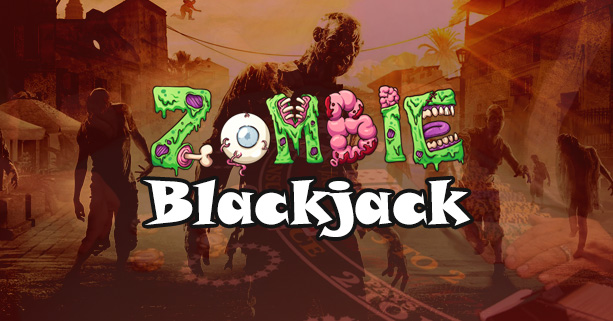With Halloween approaching, I thought it would be fun to write about some horror-themed casino games. But I didn’t want to write about slot machines. Luckily, I found a new variant of blackjack that has a spooky theme—Zombie Blackjack. This post includes how to play, what the rules differences are, and some tips on strategy.
Zombie Blackjack isn’t exactly sweeping the nation, but I understand it’s been field-tested in Las Vegas casinos. It’s the brainchild of casino game inventor Geoff Hall. He also invented Free Bet Blackjack and Blackjack Switch.
The game claims to make busting fun. The idea is that even if the player busts, he has a chance for his busted hand to come back from the dead and win. This has some interesting ramifications as they related to basic strategy and game-play. I’ll cover those below:
The Basics of How to Play Zombie Blackjack
In many respects, Zombie Blackjack is played like most other blackjack games. Casinos use either 6 or 8 decks to deal Zombie Blackjack. Each players get 2 cards face-up, and the dealer gets 2 cards—one face-up and the other face-down. The dealer always hits a soft 17 in this variation, which gives the house a little bit more edge than they would have if the dealer were required to stand on soft 17.
A dealer blackjack always wins, but you do get the option to take insurance. This is a side bet that the dealer has a total of 21. It’s a sucker bet in regular blackjack, and it’s also a sucker bet in Zombie Blackjack. If the dealer has a blackjack, you lose unless you also have a blackjack. If you also have a blackjack, the hand is considered a push. You don’t lose your bet, but you don’t get any winnings, either.
You have the usual options when playing your hand. You can stand, hit, double, or split. You can double down on any 2 cards in this variant, UNLESS you just split aces. In that case, doubling is not allowed. Other than that, doubling after splitting is fine.
If the dealer busts with 22 points, though, it’s considered a push for all hands that hadn’t busted. This is part of where the house gets its edge in this game. If you busted and had your bet set aside, it loses if the dealer has a total of 22. Some casinos pay off 3 to 2 for a blackjack in this game, but some also offer 6 to 5 payouts in Zombie Blackjack.
How Basic Strategy Works in Zombie Blackjack
You’ve probably read about basic strategy elsewhere, but in case you haven’t, here’s what that phrase means in a nutshell:
In some cases, the correct basic strategy move puts the edge in your favor. In others, it just gives you the best from a series of bad choices. If you’re in a lousy situation, sometimes the best you can do is lose as little money as possible over time. Basic strategy decisions look at your total and the dealer’s face-up card to determine what decision you should make.
Here’s an abbreviated, text-based outline of the correct basic strategy for this variant:
Your 1st decision is whether to split. If you don’t have a pair, you move on to the next matrix of decisions.
|
After deciding whether to split, your next decision is whether to double down. You’ll only double down in the following situation:
- You’ll double down on a hard 9 if the dealer has a 6 showing.
- You’ll double down on a hard 10 or 11 if the dealer has a 2, 3, 4, 5, or 6 showing. You’ll also double down on an 11 if the dealer has a 7 showing.
- You’ll double down on a soft 16 if the dealer has a 6 showing.
- You’ll double down on a soft 17 or 18 if the dealer has a 5 or 6 showing.
If none of those situations apply, all you need to do is decide whether to hit or stand. You’ll make those decisions based on the following:
|
If you’ve already memorized basic strategy for regular blackjack games, you’ll realize pretty quickly that basic strategy doesn’t change against a dealer 2, 3, 4, 5, or 6. It stays the same. The only basic strategy changes happen if the dealer has a 7 or higher showing. If you follow this basic strategy perfectly, you should face a house edge of right about 1%. That’s not the best game in the casino, but it’s not bad. This number assumes a 3 to 2 payout for a natural, too.
Don’t even play this game if the payout for a natural is only 6 to 5. You should avoid any blackjack game with a 6 to 5 payout. That one change in payout adds almost 2% to the house edge. This turns a game with a reasonable house edge of 1% into a borderline bad game with a house edge of 3%. You’re a lot better off finding a different blackjack game—maybe even at a different casino.
Conclusion
If you’re looking for a change of pace, Zombie Blackjack might be worth a try. Not all casinos offer it, but several do. You’re probably better off, house edge wise, sticking with regular blackjack. But if you’re looking for novelty, this is a fun little variation that doesn’t charge you too much for the new experience.
If you want to learn more about the game from the official site, visit Scientific Gaming. They hold the trademark for Zombie Blackjack, and they include a video on their site so you can see how the game is played. That page is aimed more at casinos than players, but it’s still useful if you want to get a better idea of the game than you got from reading this post.

 MENU
MENU











